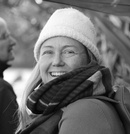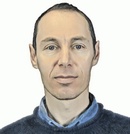Program
The proceedings are available online on IEEE Xplore.Awards
| Best Paper Award | Guided Filtering based Pyramidical Stereo Matching for Unrectified Images |
|---|---|
| Best Student Paper Award | COnGRATS: Realistic Simulation of Traffic Sequences for Autonomous Driving |
| Best Poster Award | Generalization of Otsu’s Binarizationinto Recursive Colour Image Segmentation |
Schedule
The conference program is as follows:| Mon, Nov 23 | Tue, Nov 24 | |
|---|---|---|
| 8:30–9:30 | Registrations | Registrations |
| 9:30–10:30 | Keynote: Barbara Breen | Keynote: Paul Rosin |
| 10:30–11:10 | Oral presentations | Oral presentations |
| 11:10–11:40 | Morning tea | Morning tea |
| 11:40–13:00 | Oral presentations | Oral presentations |
| 13:00–14:00 | Lunch | Lunch / IVCNZ steering committee meeting |
| 14:00–15:10 | Poster presentations | Poster presentations |
| 15:10–15:40 | Afternoon tea | Afternoon tea |
| 15:40–17:00 | Oral presentations | Oral presentations |
| 17:30–19:00 | New Zealand Robotics, Automation and Sensing AGM and Workshop |
|
| Evening | Banquet: Five Knots at the Tamaki Yacht Club |
Visiting the IVCNZ and PSIVT
The IVCNZ is co-located with the Pacific Rim Symposium on Image and Video Technology (PSIVT). Registration for the IVCNZ includes admission to the PSIVT workshops. It is possible to register for both conferences.| Mon: | IVCNZ sessions + PSIVT workshops + IVCNZ banquet |
|---|---|
| Tue: | IVCNZ sessions + PSIVT workshops |
| Wed: | PSIVT sessions |
| Thu: | PSIVT sessions + banquet |
| Fri: | PSIVT sessions |
Keynote speech: Remote sensing in conservation and ecological research
by Barbara Breen The Auckland University of Technology unmanned aerial vehicle (UAV) research team are leaders in the application of UAV technology and remote sensing in conservation and ecological research. The team works in partnership with industry to customise and develop unmanned systems for use in New Zealand and extreme environments such as Antarctica, desert systems and offshore islands. Low flying unmanned aerial vehicles (UAV) offer ecologists new opportunities to collect scale appropriate data at high spatial and temporal resolution. The presentation will showcase the use of UAVs in spatial ecology and demonstrate existing post processing tools for UAV imagery. The talk will explore opportunities for use of computer vision techniques for analysis of high resolution video imagery in a variety of environments and ecological studies. Dr Barbara Bollard Breen is a senior lecturer in the School of Applied Sciences at AUT. Her research interests
are in GIS applications, ecosystem management, cultural landscapes and spatial ecology. She has over 20 years’
experience working in government and NGO’s in both Australia and New Zealand. Her research focus has been the
identification and selection of Protected Areas, using remote sensing technology, such as UAV, to map habitats
and landscapes for conservation planning and integrating social data with environmental and biological information
using decision support systems, multivariate statistics and GIS.
Barbara Breen's website at the AUT
Dr Barbara Bollard Breen is a senior lecturer in the School of Applied Sciences at AUT. Her research interests
are in GIS applications, ecosystem management, cultural landscapes and spatial ecology. She has over 20 years’
experience working in government and NGO’s in both Australia and New Zealand. Her research focus has been the
identification and selection of Protected Areas, using remote sensing technology, such as UAV, to map habitats
and landscapes for conservation planning and integrating social data with environmental and biological information
using decision support systems, multivariate statistics and GIS.
Barbara Breen's website at the AUT
Keynote speech: Non-Photorealistic Rendering of Images
by Paul Rosin Computer Scientists have been inspired by artists to develop many non-photorealistic rendering techniques that can take an input image and produce a wide variety of artistic effects such as oil painting, watercolour, pointillist, etc. Their application can simply be for fun (e.g. to make consumer photographs more interesting), but there are also many other applications such as scientific visualisation, film production effects, technical illustration, etc. The talk will overview several NPR techniques developed by Paul Rosin and Yu-Kun Lai, that aim to generate results that are relatively minimal rendering, in terms of using a combination of refined lines and regions and a small number of tones or colours. The aim is to achieve a rendering that is abstracted but retains sufficient elements from the original image so that (for example) it can be used to generate recognisable portraits. Paul L. Rosin is a Professor at the School of Computer Science & Informatics, Cardiff University.
Previous posts include Brunel University, Joint Research Centre, Italy and Curtin University of Technology,
Australia. His research interests include shape analysis, curve segmentation, low level image processing,
machine vision approaches to remote sensing, medical and biological image analysis, mesh processing,
non-photorealistic rendering, the analysis of shape in art and architecture, and application of cellular
automata to image processing.
Paul Rosin's website at Cardiff University, UK
Paul L. Rosin is a Professor at the School of Computer Science & Informatics, Cardiff University.
Previous posts include Brunel University, Joint Research Centre, Italy and Curtin University of Technology,
Australia. His research interests include shape analysis, curve segmentation, low level image processing,
machine vision approaches to remote sensing, medical and biological image analysis, mesh processing,
non-photorealistic rendering, the analysis of shape in art and architecture, and application of cellular
automata to image processing.
Paul Rosin's website at Cardiff University, UK
Detailed conference program
Monday, Nov. 23:| Paper no. | 10:30–11:10 Oral presentations |
|---|---|
| 70 | COnGRATS: Realistic Simulation of Traffic Sequences for Autonomous Driving |
| 127 | Guided Filtering based Pyramidical Stereo Matching for Unrectified Images |
| 11:40–13:00 Oral presentations | |
| 45 | Optimal Space Subdivision for Parallel Approximate Nearest Neighbour Determination |
| 47 | An Information Theoretic Approach to Reflectional Symmetry Detection |
| 71 | Mutual Information of Image Intensity and Gradient Flux for Markerless Pose Estimation |
| 72 | Self-normalising linear camera resection |
| 14:00–15:10 Poster presentations | |
| 2 | Texture-aware Edit Propagation |
| 18 | A Triangulation-based Technique for Building Boundary Identification from Point Cloud Data |
| 20 | How to select hashing bits? A direct measurement approach |
| 27 | Hybrid Superpixel Segmentation |
| 30 | A Model for Honey Bee Tracking On 2D Video |
| 37 | A No-Reference Image Enhancement Quality Metric and Fusion Technique |
| 44 | Place Recognition By Using Multiple Feature Types |
| 46 | Generalisation of Otsu’s Binarization into Recursive Colour Image Segmentation |
| 49 | Leaf image retrieval using combined feature of vein and contour |
| 55 | Global Sparsity Potentials for Obstacle Detection from Unmanned Surface Vehicles |
| 76 | Feature Tracking Using Epipolar Geometry for Ego-Motion Estimation |
| 89 | A Hidden Markov Model For Modeling and Extracting Vine Structure in Images |
| 100 | Introduction of a Human Based Attention Model for Robotic navigation |
| 103 | Two Parallel Deep Convolutional Neural Networks for Pedestrian Detection |
| 109 | Automatic Alignment and Comparison on Images of Petri Dishes containing Cell Colonies |
| 118 | Ensemble Classification with modified SIFT Descriptor for Medical Image Modality |
| 119 | Object Recognition using ColourFAST Feature Point Clusters |
| 129 | Palette Based Colour Transfer using Image Segmentation |
| 137 | Long Range Image Enhancement |
| 143 | ‘Affordance’ detection by mid-level physical parts |
| 15:40–17:00 Oral presentations | |
| 59 | Accurate Marker Based Distance Measurement with Single Camera |
| 102 | Learning Long-range Local Ternary Patterns for Texture Recognition |
| 114 | Coping with motion in MRI: developments since TRELLIS |
| 147 | Vectorised SIMD Implementations of Morphology Algorithms |
| Time | 17:30–19:00 New Zealand Robotics, Automation and Sensing |
|---|---|
| 17:30 | |
| 18:00 | Inspection Robotics & Assistive technology in Medicine: Will Browne Autonomous Robotics in Rugged Outdoor Environments: Bruce MacDonald UAVs: Richard Green 3D Reconstruction: Steven Mills Sensor development: Ian Woodhead & John Kennedy |
| 18:20 | Speakers TBA |
| 18:40 |
| Paper no. | 10:30–11:10 Oral presentations |
|---|---|
| 40 | Hyperspectral Image Coding using Spectral Prediction Modelling in HEVC Coding Framework |
| 125 | Texture Modelling with Non-contiguous Filters |
| 11:40–13:00 Oral presentations | |
| 61 | Sharpness and Contrast Measures on Videos |
| 77 | A Hybrid Genetic Programming Approach to Feature Detection and Image Classification |
| 82 | Foreground Motion and Spatial Saliency-based Efficient HEVC Video Coding |
| 98 | The Volume Radius Function: A new Descriptor for the Segmentation of Volumetric Medical Images |
| 14:00–15:10 Poster presentations | |
| 9 | Periocular recognition under expession variation using Higher Order Spectral features |
| 13 | Extracting Road Centerlines from Binary Road Images by Optimizing Geodesic Lines |
| 14 | Toward a Real-time Belief Propagation Stereo Reconstruction for Computers, Robots, and Beyond |
| 17 | Lumen Coronary Artery Border Detection Using Texture and Chi-square Classification |
| 21 | SHORT: A Fast 3D Feature Description based on Estimating Occupancy in Spherical Shell Regions |
| 23 | Perceptual Threshold in DWT For Optimum Embedding Rate in Data Hiding Using HVS and GA |
| 36 | Regularized Logistic Regression Algorithm Learns Progressive Sweep Algorithm |
| 43 | Facial Expression Recognition by Correlated Topic Models and Bayes Modeling |
| 57 | Semi-global Stereo Matching Under Large and Spatially Variant Perceptive Deviations |
| 60 | Novel Methods for Reflective Symmetry Detection in Scanned 3D Models |
| 66 | Image Quality Assessment Based On Properties of HVS and Principle of Image Structure |
| 74 | Modified total variation regularization using fuzzy complement for image denoising |
| 75 | Road Detection via Unsupervised Feature Learning |
| 87 | Deep Convolutional Neural Networks for Dense Non-Uniform Motion Deblurring |
| 92 | Synthesizing Radiance Maps from Legacy Outdoor Photographs for Real-time IBL on HMDs |
| 106 | Uniqueness for ab initio phase retrieval in macromolecular X-ray crystallography |
| 110 | Free View-Point Video Synthesis Using Gaussian Mixture Modelling |
| 111 | A Novel Method for Video Enhancement – RGB Local Context-based Fusion |
| 113 | Weakly supervised 3D Reconstruction of the Knee Joint from MR Images Using a Volumetric Active Appearance Model |
| 124 | Point Tracking on a thin elastomer to emulate Skin-stretch induced motion artifacts in Electrocardiogram measurement |
| 126 | A Depth Video-based Facial Expression Recognition System Using GDA, LDP, Optical Flows, and HMM |
| 128 | A New Method of Flash Image Shadow Detection and Patch-based Correction of Shadow Regions |
| 131 | Nonlocal Mathematical Morphology and Spatially-Variant Connected operators |
| 134 | Automatic 3D Face Landmark Localization Based on 3D Vector Field Analysis |
| 135 | Feasibility of a semi-automated approach to grading point of care ultrasound image generation skills |
| 142 | Tsai’s calibration applied for close-range hydraulic engineering research |
| 148 | Perception Scheme for Fruits Detection in Trees for Autonomous Agricultural Robot Applications |
| 15:40–17:00 Oral presentations | |
| 83 | Use of Spatio-Temporal Modeling for Age Invariant Face Recognition |
| 90 | Adapting Generic Trackers for Tracking Faces |
| 99 | A Hand-held Low-cost Stereoscopic Device for Measuring Dynamic Deformations of Skin In Vivo |
| 138 | Video-based Document Image Scanning Using a Mobile Device |





